AUCTION FINDS OF THE WEEK- JUNE 10TH: 20TH CENTURY DESIGN PART II
by Kelly Keating on 06/10/13
This week's auction finds are all examples of high end 20th century design. All this week's discoveries are from France except one which is from the United States but it relates quite well to 2 of our French lots. These 6 objects are all being auctioned off at Christie's NY on June 13, 2013. I hope these pieces will be a source of inspiration for the design of your own space.
This week's first treasure is desk circa 1955 by our old friend Jean Royere (1902-1981). A wonderful marquetry sideboard was featured in the auction finds of the week from April 29th. The piece was auctioned in Paris and realized $38,595.
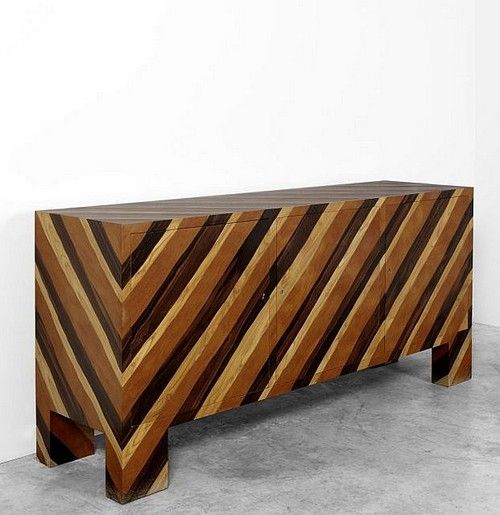
The desk being auctioned on June 13th is made of mahogany, brass and cane. It has a wonderful architectural and sculptural feel, full of straight lines and angles in contrast to the organic materials especially the cane of its construction. It almost doesn't look functional, it's futuristic, but more of an elegant decorative objet d'art, a piece of sculpture to inhabit your room. The desk, lot 187, has a pre-sale estimate of $20,000-30,000.

This week's second find is also by Jean Royere- a bibliotheque circa 1937, lot 184, with a pre-sale estimate of $25,000-35,000. The bookcase is made of zebrawood and sycamore with bronze detailing. It has glass doors in the center behind which are adjustable shelves. This piece is deceptively simple in its architectural form. The surface of the bookcase is enlivened by the striped patterning of the zebrawood against the transparency of the glass and the hard edge of the bronze border which surrounds the facade's wood panels.
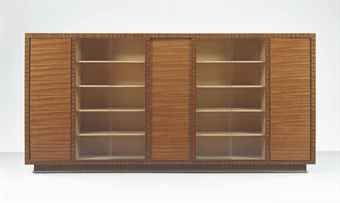
The next discovery for this week is a circa 1934 armchair by Pierre Patout (1879-1965), lot 334 with a pre-sale estimate of $6,000-8,000. Patout was an architect, urban planner and interior decorator. He worked in Rueil briefly before founding one of the first group practices in Paris with Levard in 1910. He contributed several projects to the Exposition internationale des arts decoratifs et industriels modernes, Paris, in 1925, including the Porte de la Concorde, and pavilions for the Manufacture Nationale de Sevres and for Jacques-Emile Ruhlmann's Hotel d'un Collectionneur. With their neo-classical vocabulary enhanced by Cubist-influenced sculptural reliefs, these buildings are typical of his Art Deco style; his prestigious town houses (for Ducharne, Paris, 1924 (destr.); for the Voisins, Boulogne-Billancourt, 1923 (destr.) and 1928; for the painter Alfred Lombard and his son, Boulogne-Billancourt, 1928) and blocks of flats (at the Porte de Champerret, 1928; and the Square Henri Path, 1928) are also characteristic. In 1926 he designed the first in a series of shops for the wine-merchants Nicolas.
The armchair was designed for use in the First Class Dining Room of the ocean liner Normandie. The piece is made of mahogany. Its legs end in brass sabots and it has its original woven tapestry upholstery. The chair has a wonderful Art Deco style and evokes the heydey of transatlantic ocean travel. It would be great to build a room around this chair as the centerpiece and perhaps one could eventually find a mate to make a lovely pair.
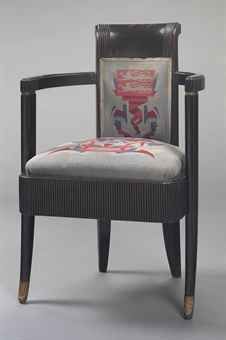
The fourth discovery this week is pair of walnut Art Nouveau armchairs by Louis Majorelle (1859-1926), lot 303 with a pre-sale estimate of $7,000-9,000. Majorelle was a French decorator and furniture designer who manufactured his own designs, in the French tradition of the ébéniste. He was one of the outstanding designers of furniture in the Art Nouveau style.
The armchairs have a wonderfully sinuous and organic feel particularly how the arms continue straight down into the legs of the chairs. The arms and legs are not smooth, but are covered with and enlivened by meandering tendrils. The crest rail has a lovely fan shape with a carved spray of flowers. And I think that Art Nouveau should be considered yet another revival expression of the Rococo with its curving forms and sinewy elegance.
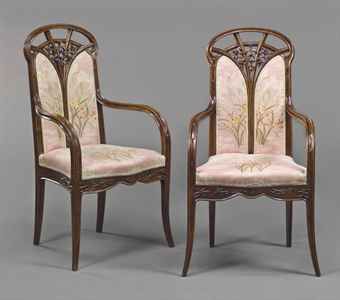
The fifth treasure this week is an unusual Art Nouveau lot and it would be interesting to see how the buyer eventually uses the piece. Lot 129 is a balcony railing circa 1903 by French architect Hector Guimard (1867-1942). The balcony railing is made of cast iron. This railing design was used on the exterior of many of Guimard's buildings in Paris including 17-19 rue la Fontaine, 43 rue Gros, Hôtel Mezzara and the Tremois Apartments, 11 rue François-Millet. The Art Nouveau style of the railing is expressed in its wonderfully curvy and sinous form. There is not a straight line anywhere.
How would one use this piece? Why not mount it on a wall in the drawing room making it the centerpiece and focal point of the room. It could be the starting point for a very creative space.

The last find for the week is not French but American, but also an expression of the Art Nouveau moment of the Majorelle armchairs and Guimard balcony railing. Lot 122 is a Tiffany Studios six light tulip chandelier, circa 1910, with a pre-sale estimate of $12,000-18,000. The piece is made of favrile glass and bronze. It is a delightfully warm organic piece and much more appealing to me than the multi-colored Tiffany table lamps whose original beauty I think has been damaged by all of the ersatz imitators. This chandelier would work well in a variety of settings from a sleek modern room to something more transitional or traditional.
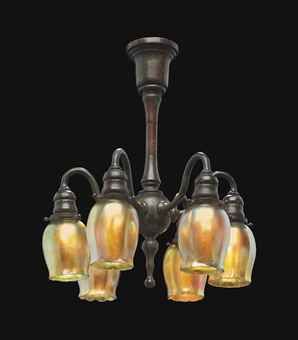
This week has been an interesting tour from 1950's modernism to Art Deco to Art Nouveau. My favorite find this week is the Pierre Patout armchair that was made for the Normandie ocean liner. For me it evokes the romance of transatlantic travel, when travel was an art, rather than a chore where one is packed in tight with few amenities or luxuries. It would be fab to use the Patout chair and the colors and feel of its upholstery as the starting point of a room and hopefully a mate would come along one day to complete the setting.
Until next week.
If you are looking for an antique or vintage treasure and would like my help, please contact me at [email protected]
Kelly T Keating
www.theantiqueflaneur.com
